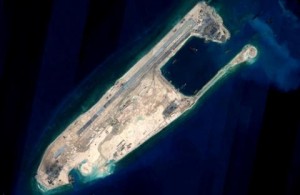Commentary by:

President & Senior Research Fellow, National Institute for South China Sea Studies

U.S. South China Sea policies have undergone several rounds of profound changes since the end of the 1990s, evolving from “staying neutral” to “limited intervention,” and then “active intervention.” This is because, on the one hand, with Chinese comprehensive national strength continuously rising and its relative capabilities growing at sea, Chinese policies regarding the South China Sea have become increasingly clear and a maritime order in the South China Sea dominated by China is beginning to take shape. While pressing ahead with its pivot to the Asia-Pacific, the US is gradually enhancing its preventive containment of China. On the other hand, the U.S. is reducing its policy of “neutrality” into a nominal existence, getting involved more and more deeply in maritime disputes in the South China Sea, and China-U.S. rivalry in the area is unprecedentedly tense. In retrospect, adjustments and evolution of Washington’s South China Sea policies in recent years can be summed up as three gains and three worries.
The first gain is, by supporting the Philippines to submit its maritime dispute with China to the International Tribunal for The Law of The Sea, it has subjected China to direct challenges and pressures from international multilateral mechanisms. In January 2013, with the open support of the U.S., the Philippines unilaterally proposed a compulsory arbitration procedure against China, against both China’s will and the commitment Manila had made in bilateral and multilateral agreements to solving the South China Sea dispute through friendly consultations and negotiations.
The second gain is the U.S. has adamantly supported the Philippines in “safeguarding” Ren’ai Reef, providing moral and practical support for the latter’s attempt to permanently control it. This is because maintaining the China-Philippines territorial dispute in the South China Sea is not only consistent with U.S. interests, but also facilitates its rebalancing to the periphery of the South China Sea and supports its military deployments against China.
The third gain is, taking advantage of the dispute over oil rig 981, it on the one hand supported Vietnam to create new troubles for China on the Xisha Islands issue, on the other hand actually lifted its lethal weapons embargo against Vietnam. The China-Vietnam dispute in the South China Sea has provided opportunities for the U.S. to contain China.
Besides harvesting the three gains on the South China Sea issue, the U.S. also has absorbed three unexpected worries.
First, it is worried that China will dominate rule-making in the South China Sea. Since the 1990s, China and the Association of Southeastern Asian Nations have reached consensus on launching consultations about a code of conduct in the South China Sea. In 2002, the two parties signed the Declaration on the Conduct of Parties in the South China Sea (DOC); in 2011, they signed the Guidelines for the Implementation of the DOC; in 2013, the two sides reached a new consensus on accelerating consultations about the proposed Code of Conduct in the South China Sea; in 2014, China put forward the dual-track approach that “disputes over the South China Sea be resolved through consultation and negotiation between disputing parties, peace and stability of the South China Sea be jointly preserved by China and the ASEAN”. It is thus evident that China may firmly dominate future rule-making regarding the South China Sea.
Second, it is worried that China may obtain overwhelming sea power in the South China Sea. With global geopolitical gaming centered around the oceans getting increasingly fierce, the U.S. pressing ahead with its strategic pivot to the Asia-Pacific, and exploitation of maritime resources by coastal nations extending from offshore to the high seas, disputes in the South China Sea have evolved from those between claimant countries over sovereignty and maritime jurisdiction over islands and reefs to fierce gaming in such areas as geopolitical competition, natural resources exploitation, and waterway control among claimant nations and stakeholding parties. China-U.S. competition in the South China Sea has thus upgraded from the previous concerns about freedom of navigation to those regarding dispute resolution mechanisms, rules on navigations and over-flight in the South China Sea, and the legal status of the dash line in the South China Sea.
Third, it is worried that China may declare an Air Defense Identification Zone in the South China Sea. Since China declared its East China Sea Air Defense Identification Zone in November 2013, the U.S. and the international community have either worried or predicted that it will soon announce an ADIZ for the South China Sea. China has repeatedly stated there is no need for such a zone for the time being. Though it is within Chinese sovereignty, whether or not it will declare a new ADIZ will depend on its evaluation of security conditions in the South China Sea. China’s ongoing construction activities on isles and reefs in the Nansha area have again struck American nerves. In a certain sense, it is more concerned about the possibility of the consequent declaration of the feared ADIZ than about the speed or scale of such construction projects.
The South China Sea is a natural line of defense for Chinese national security, an important strategic waterway, and a strategic must-have for it to become a maritime power. For the U.S., controlling the South China Sea and maintaining its presence there is indispensable for its dominance in the Asia-Pacific based on its bilateral alliances formulated in the post-war era. In this sense, China-U.S. competition and rivalry in the South China Sea is structural, strategic, and irreconcilable.
Given the implementation of the U.S. pivot to the Asia-Pacific and adjustments in its South China Sea policies, the South China Sea issue is no longer just disputes between China and several other claimant nations about sovereignty over islands and reefs and maritime jurisdiction. It has become a very complicated one with China-U.S. conflicts assuming center stage, and those between China and other claimants in the background. Meanwhile, the South China Sea will be an important and unavoidable issue in China-U.S. relations. Therefore, managing China-U.S. disagreements over the South China Sea and preventing conflicts there from damaging bilateral ties is a practical imperative for decision-makers in both countries.
The U.S. should understand and take into consideration Chinese concerns and interests in the South China Sea, honor its pledge of “neutrality” on the issue, restrain its close-in surveillance and reconnaissance flights against China, and prove with actions its claim that it has no intention to contain China with the South China Sea issue. China should respect U.S. freedom of navigation and over-flight in the South China Sea based on international law, try its best to avoid unilaterally declaring the anticipated South China Sea ADIZ that may undermine political mutual trust and security cooperation, truly speed up consultations on the code of conduct so as to deal with the absence of security and crisis control mechanisms in the South China Sea, prioritize civilian functions in construction activities on the isles and reefs there, and be prudent about military facilities that go beyond defense purposes. From the perspective of mechanism building, the two parties can consider setting up a track 1 or track 1.5 “China-U.S. working group for consultations on maritime issues” under their Strategic and Economic Dialogue. When conditions are ripe, they can also consider hotlines between naval commanders.
This article first appeared on the China-US Focus website on June 25, 2015.

The Institute for China-America Studies is an independent nonprofit, nonpartisan research organization dedicated to strengthening the understanding of U.S.-China relations through expert analysis and practical policy solutions.
1919 M St. NW Suite 310,
Washington, DC 20036
icas@chinaus-icas.org
(202) 968-0595
© 2025 INSTITUTE FOR CHINA-AMERICA STUDIES. ALL RIGHTS RESERVED.
A Test for the Future of Global Ocean Law